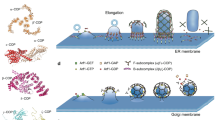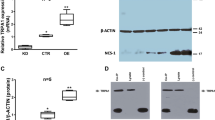Abstract
Members of the Rem, Rem2, Rad, Gem/Kir (RGK) family of small GTP-binding proteins inhibit high-voltage-activated (HVA) Ca2+ channels through interactions with both the principal α1 and the auxiliary β subunits of the channel complex. Three highly conserved residues of Rem (R200, L227, and H229) have been shown in vitro to be critical for interactions with β subunits. However, the functional significance of these residues is not known. To investigate the contributions of R200, L227, and H229 to β subunit-mediated RGK protein-dependent inhibition of HVA channels, we introduced alanine substitutions into all three positions of Venus fluorescent protein-tagged Rem (V-Rem AAA) and made three other V-Rem constructs with an alanine introduced at only one position (V-Rem R200A, V-Rem L227A, and V-Rem H229A). Confocal imaging and immunoblotting demonstrated that each Venus-Rem mutant construct had comparable expression levels to Venus-wild-type Rem when heterologously expressed in tsA201 cells. In electrophysiological experiments, V-Rem AAA failed to inhibit N-type Ca2+ currents in tsA201 cells coexpressing CaV2.2 α1B, β3, and α2δ-1 channel subunits. The V-Rem L227A single mutant also failed to reduce N-type currents conducted by coexpressed CaV2.2 channels, a finding consistent with the previous observation that a leucine at position 227 is critical for Rem-β interactions. Rem-dependent inhibition of CaV2.2 channels was impaired to a much lesser extent by the R200A substitution. In contrast to the earlier work demonstrating that Rem H229A was unable to interact with β3 subunits in vitro, V-Rem H229A produced nearly complete inhibition of CaV2.2-mediated currents.





Similar content being viewed by others
References
Bannister RA, Colecraft HM, Beam KG (2008) Rem inhibits excitation-contraction coupling in skeletal muscle by down-regulating the number of functional L-type Ca2+ channels. Biophys J 94:2631–2638. doi:10.1529/biophysj.107.116467
Béguin P, Mahalakshmi RN, Nagashima K, Cher DH, Ikeda H, Seino Y, Hunziker W (2006) Nuclear sequestration of beta-subunits by Rad and Rem is controlled by 14-3-3 and calmodulin and reveals a novel mechanism for Ca2+ channel regulation. J Mol Biol 355:34–46. doi:10.1016/j.jmb.2005.10.013
Béguin P, Nagashima K, Gonoi T, Shibasaki T, Takahashi K, Kashima Y, Ozaki N, Geering K, Iwanaga T, Seino S (2001) Regulation of Ca2+ channel expression at the cell surface by the small G-protein kir/Gem. Nature 411:701–706. doi:10.1038/35079621
Béguin P, Ng YJ, Krause C, Mahalakshmi RN, Ng MY, Hunziker W (2007) RGK small GTP-binding proteins interact with the nucleotide kinase domain of Ca2+ channel β-subunits via an uncommon effector-binding domain. J Biol Chem 282:11509–11520. doi:10.1074/jbc.M606423200
Beqollari D, Romberg CF, Papadopoulos S, Meza U, Bannister RA (2014) Differential effects of RGK proteins on L-type channel function in adult mouse skeletal muscle. Biophys J 106:1950–1957. doi:10.1016/j.bpj.2014.03.033
Brosenitsch TA, Katz DM (2001) Physiological patterns of electrical stimulation can induce neuronal gene expression by activating N-type calcium channels. J Neurosci 21:2571–2579
Chen H, Puhl HL, Niu S-L, Mitchell DC, Ikeda SR (2005) Expression of Rem2, an RGK family small GTPase, reduces N-type calcium current without affecting channel surface density. J Neurosci 25:9762–9772. doi:10.1523/JNEUROSCI. 3111-05.2005
Crump SM, Correll RN, Schroder EA, Lester WC, Finlin BS, Satin J, Andres DA (2006) L-type calcium channel α-subunit and protein kinase inhibitors modulate Rem-mediated regulation of current. Am J Physiol 291:H1959–H1971. doi:10.1152/ajpheart.00956.2005
Dunlap K, Luebke J, Turner T (1995) Exocytotic Ca2+ channels in mammalian central neurons. Trends Neurosci 18:89–98
Fan M, Buraei Z, Luo HR, Levenson-Palmer R, Yang J (2010) Direct inhibition of P/Q-type voltage-gated Ca2+ channels by Gem does not require a direct Gem/Cavβ interaction. Proc Natl Acad Sci U S A 107:14887–14892. doi:10.1073/pnas.1007543107
Fan M, Zhang WK, Buraei Z, Yang J (2012) Molecular determinants of Gem protein inhibition of P/Q-type Ca2+ channels. J Biol Chem 287:22749–22758. doi:10.1074/jbc.M111.291872
Finlin BS, Correll RN, Pang C, Crump SM, Satin J, Andres DA (2006) Analysis of the complex between Ca2+ channel β-subunit and the Rem GTPases. J Biol Chem 281:23557–23566. doi:10.1074/jbc.M604867200
Finlin BS, Crump SM, Satin J, Andres DA (2003) Regulation of voltage-gated Ca2+ channel activity by the Rem and Rad GTPases. Proc Natl Acad Sci U S A 100:14469–14474. doi:10.1073/pnas.2437756100
Fisher TE, Bourque CW (2001) The function of Ca2+ channel subtypes in exocytotic secretion: new perspectives from synaptic and non-synaptic release. Prog Biophys Mol Biol 77:269–303. doi:10.1016/S0079-6107(01)00017-7
Flynn R, Chen L, Hameed S, Spafford JD, Zamponi GW (2008) Molecular determinants of Rem2 regulation of N-type calcium channels. Biochem Biophys Res Commun 368:827–831. doi:10.1016/j.bbrc.2008.02.020
Maltez JM, Nunziato DA, Kim J, Pitt GS (2005) Essential CaVβ modulatory properties are AID-independent. Nat Struct Mol Biol 12:372–377
Manning JR, Yin G, Kaminski CN, Magyar J, Feng HZ, Penn J, Sievert G, Thompson K, Jin JP, Andres DA, Satin J (2013) Rad GTPase deletion increases L-type calcium channel current leading to increased cardiac contraction. J Am Heart Assoc 2:e000459. doi:10.1161/JAHA.113.000459
Meza U, Beqollari D, Romberg CF, Papadopoulos S, Bannister RA (2013) Potent inhibition of L-type Ca2+ currents by a Rad variant linked to human cardiac hypertrophy. Biochem Biophys Res Commun 439:270–274. doi:10.1016/j.bbrc.2013.08.044
Murata M, Cingolani E, McDonald AD, Donahue K, Marbán E (2004) Creation of a genetic calcium channel blocker by targeted Gem gene transfer in the heart. Circ Res 95:398–405. doi:10.1161/01.RES.0000138449.85324.c5
Puhl HL III, Lu VB, Won Y-J, Sasson Y, Hirsch JA, Ono F, Ikeda SR (2014) Ancient origins of RGK protein function: modulation of voltage-gated calcium channels preceded the protosome and deuterstome split. PLoS One 9:e100694. doi:10.1371/journal.pone.0100694
Romberg CF, Beqollari D, Meza U, Bannister RA (2014) RGK protein-mediated impairment of slow depolarization-dependent Ca2+ entry into developing myotubes. Channels 8:243–248. doi:10.4161/chan.27686
Sasaki T, Shibasaki T, Béguin P, Nagashima K, Miyazaki M, Seino S (2005) Direct inhibition of the interaction between alpha-interaction domain and beta-interaction domain of voltage-dependent Ca2+ channels by Gem. J Biol Chem 280:9308–9312
Seu L, Pitt GS (2006) Dose-dependent and isoform-specific modulation of Ca2+ channels by RGK GTPases. J Gen Physiol 128:605–613
Simms BA, Zamponi GW (2014) Neuronal voltage-gated calcium channels: structure, function, and dysfunction. Neuron 82:24–45. doi:10.1016/j.neuron.2014.03.016
Wang G, Zhu X, Xie W, Han P, Li K, Sun Z, Wang Y, Chen C, Song R, Cao C, Zhang J, Wu C, Liu J, Cheng H (2010) Rad as a novel regulator of excitation-contraction coupling and β-adrenergic signaling in heart. Circ Res 106:317–327. doi:10.1161/ CIRCRESAHA.109.208272
Ward Y, Spinelli B, Quon MJ, Chen H, Ikeda SR, Kelly K (2004) Phosphorylation of critical serine residues in Gem separates cytoskeletal reorganization from down-regulation of calcium channel activity. Mol Cell Biol 24:651–661
Wheeler DB, Randall A, Tsien RW (1994) Roles of N-type and Q-type Ca2+ channels in supporting hippocampal synaptic transmission. Science 264:107–111
Wu L-G, Saggau P (1997) Presynaptic inhibition of elicited neurotransmitter release. Trends Neurosci 20:204–212
Xu X, Colecraft HM (2009) Engineering proteins for custom inhibition of CaV channels. Physiology 24:210–218. doi:10.1152/physiol.00010.2009
Xu X, Marx SO, Colecraft HM (2010) Molecular mechanisms, and selective pharmacological rescue, of Rem-inhibited CaV1.2 channels in heart. Circ Res 107:620–630. doi:10.1161/CIRCRESAHA.110.224717
Xu X, Zhang F, Zamponi GW, Horne WA (2015) Solution NMR and calorimetric analysis of Rem2 binding to the Ca2+ channel β4 subunit: a low affinity interaction is required for inhibition of CaV2.1 Ca2+ currents. FASEB J, in press.
Yada H, Murata M, Shimoda K, Yuasa S, Kawaguchi H, Ieda M, Adachi T, Ogawa S, Fukuda K (2007) Dominant negative suppression of Rad leads to QT prolongation and causes ventricular arrhythmias via modulation of L-type Ca2+ channels in the heart. Circ Res 101:69–77. doi:10.1161/CIRCRESAHA.106.146399
Yang SN, Berggren PO (2006) The role of voltage-gated calcium channels in pancreatic beta-cell physiology and pathophysiology. Endocr Rev 6:621–676. doi:10.1210/er.2005-0888
Yang T, Colecraft HM (2013) Regulation of voltage-dependent calcium channels by RGK proteins. Biochim Biophys Acta Biomembranes 1828:1644–1654. doi:10.1016/j.bbamem.2012.10.005
Yang T, He LL, Chen M, Fang K, Colecraft HM (2013) Bio-inspired voltage-dependent calcium channel blockers. Nat Commun 4:2540. doi:10.1038/ncomms3540
Yang T, Puckerin A, Colecraft HM (2012) Distinct RGK GTPases differentially use α1- and auxiliary β-binding-dependent mechanisms to inhibit CaV1.2/CaV2.2 channels. PLoS One 7:e37079. doi:10.1371/journal.pone.0037079
Yang T, Suhail Y, Dalton S, Kernan T, Colecraft HM (2007) Genetically encoded molecules for inducibly inactivating CaV channels. Nat Chem Biol 3:795–804. doi:10.1038/nchembio.2007.42
Yang T, Xu X, Kernan T, Wu V, Colecraft HM (2010) Rem, a member of the RGK GTPases, inhibits recombinant CaV1.2 channels using multiple mechanisms that require distinct conformations of the GTPase. J Physiol 588:1665–1681. doi:10.1113/jphysiol.2010.187203
Acknowledgments
We thank Dr. U. Meza for comments on the manuscript, Drs. B.A. Adams. S.R. Ikeda, P.J. Kammermeier, H.L. Puhl, III, and W.A. Sather for sharing expression plasmids and Drs. K.G. Beam and D. Oskar for continued support. This work was supported by grants from the American Heart Association (13BGIA13630000) and the Boettcher Foundation to R.A.B.. D.B. received a stipend from 2T32AG000279-11 (to R.S. Schwartz, University of Colorado Denver-AMC Department of Medicine-Geriatrics Division). Confocal images were acquired in the University of Colorado Denver-AMC Advanced Light Microscopy Core (funded in part by NIH/NCRR Colorado CTSI Grant Number UL1 RR025780).
Compliance with Ethical Standards
Disclosure of potential conflicts of interest: None of the authors have a competing interest. Research involving Human Participants and/or Animals: N/A. Informed consent: N/A.
Author information
Authors and Affiliations
Corresponding author
Rights and permissions
About this article
Cite this article
Beqollari, D., Romberg, C.F., Filipova, D. et al. Functional assessment of three Rem residues identified as critical for interactions with Ca2+ channel β subunits. Pflugers Arch - Eur J Physiol 467, 2299–2306 (2015). https://doi.org/10.1007/s00424-015-1700-x
Received:
Accepted:
Published:
Issue Date:
DOI: https://doi.org/10.1007/s00424-015-1700-x




